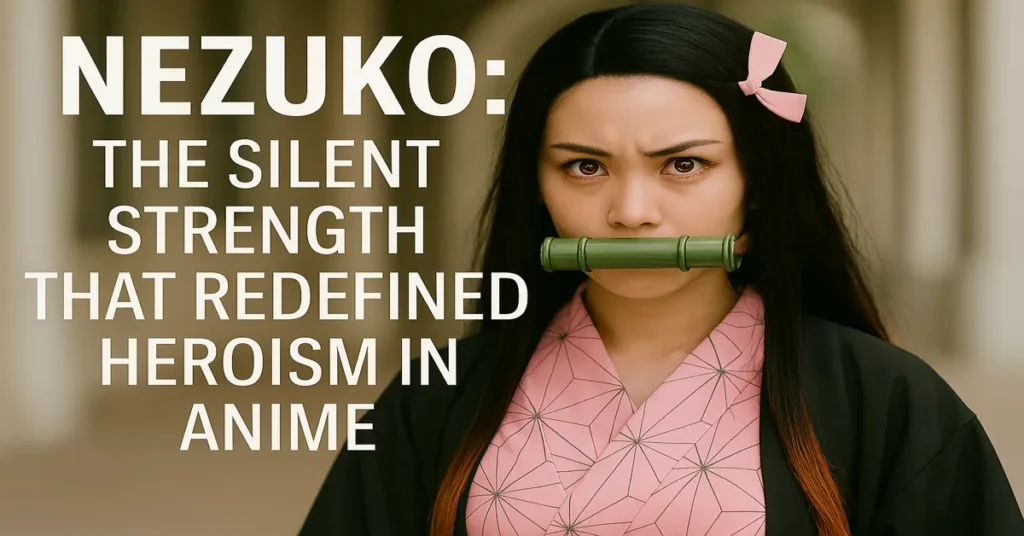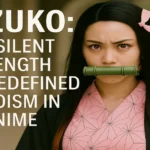In the sprawling pantheon of anime heroes — swordsmen, warriors, sorcerers, pilots — a singular figure stands quietly apart: Nezuko Kamado.
With no grand speeches, no world-saving monologues, and for much of the story, no human words at all, Nezuko has captured the hearts of millions around the globe.
Her story — of survival, sacrifice, and silent resilience — echoes deeper truths about modern heroism, family, femininity, and the redefinition of strength in popular storytelling.
Today, Nezuko is more than a fictional character. She is a cultural force — and a symbol of how vulnerability, not bombast, can inspire profound change.
This is her story.
Origins: A Tragedy Forged in Fire
Demon Slayer: Kimetsu no Yaiba, the manga and anime phenomenon created by Koyoharu Gotouge, introduces Nezuko in devastation.
- Her family slaughtered by demons.
- Her humanity stripped away by transformation.
- Her fate rewritten in an instant.
Yet from the moment Nezuko reappears — bloodied, fanged, feral — something crucial distinguishes her:
She resists.
Against the instinct to kill, to consume, to abandon everything she once was, Nezuko clings to a sliver of her human soul — a bond to her brother, Tanjiro, that transcends biology or curse.
In that moment, Nezuko’s arc begins — not one of conquest, but of retention: retaining compassion in a world bent on erasing it.
Silent But Unforgettable: Nezuko’s Unique Voice
Unlike typical anime heroines, Nezuko spends most of Demon Slayer unable to speak.
Muzzled — literally, with a bamboo gag designed to prevent harm — she communicates through:
- Body language.
- Facial expressions.
- Emotional resonance.
In a medium dominated by dialogue-heavy exposition, Nezuko’s silent presence feels revolutionary.
It demands a new kind of engagement from viewers:
- We read her emotions, not hear them.
- We feel her struggle, not simply listen to it.
This narrative device makes Nezuko one of anime’s most physically expressive characters, drawing on traditions of silent cinema and classical theater rather than typical animated tropes.
The Design of a Symbol: How Nezuko’s Appearance Amplifies Her Story
Nezuko’s visual design is meticulously crafted to mirror her internal paradox:
- Pink Eyes and Kimono:
Signals purity, innocence, and lost humanity. - Sharp Fangs and Clawed Hands:
A reminder of the monstrous transformation within. - Bamboo Muzzle:
At once restraint and dignity — she refuses to harm, even involuntarily.
Her physical transformation scenes — where she grows in size and ferocity during battles — further embody duality: beauty and horror, humanity and monstrosity, peace and fury.
In Nezuko, Demon Slayer offers a potent visual metaphor:
Even under monstrous exterior forces, the core of who we are — our loyalty, our love — can endure.
Nezuko as Subversion: Redefining the “Damsel” Archetype
Traditionally, anime heroines have often fallen into predictable roles:
- The Damsel:
A figure needing protection. - The Warrior:
A fierce fighter, often masculinized to earn respect.
Nezuko subverts both:
- She is protected by Tanjiro, yet also protects him.
- She is gentle yet devastatingly powerful.
- She is infantilized visually, yet treated narratively as an autonomous agent.
At key moments — like when she shields Tanjiro from deadly attacks or unleashes demon blood arts — Nezuko asserts agency in ways that reject passive victimhood without abandoning empathy or care.
In doing so, she redefines what feminine strength can look like in storytelling:
Not the absence of vulnerability, but its transformation into unyielding courage.
The Power of Family: Nezuko and Tanjiro’s Bond
Central to Nezuko’s narrative arc is her relationship with her brother, Tanjiro.
Their bond transcends:
- Species: human and demon.
- Duty: personal loyalty over institutional mandates.
- Survival: protecting each other at all costs.
In a genre often preoccupied with revenge, glory, or ambition, Demon Slayer stakes its emotional power on love — humble, familial, unconditional love.
Nezuko’s commitment to Tanjiro — even when her demon instincts flare — is a powerful rebuke to narratives of cynical survivalism.
Instead, it posits a radical idea:
That tenderness, even in a brutal world, can be revolutionary.
Transformation and Control: Nezuko’s Unique Demon Physiology
As a demon, Nezuko possesses astonishing abilities:
- Size Manipulation:
Shrinking to childlike form or growing into towering strength. - Accelerated Regeneration:
Healing at rates rivaling powerful demons. - Blood Demon Art – Exploding Blood:
Igniting her own blood to damage demons while leaving humans unharmed.
Yet what defines Nezuko’s power is not raw strength but control:
Unlike other demons, she resists consuming humans.
She regenerates not through feeding, but through sheer will.
In this, Nezuko embodies a profound metaphor:
Survival without surrender.
Her arc challenges assumptions that power inevitably corrupts — suggesting instead that the true measure of strength lies in restraint, compassion, and conscious choice.
Global Impact: Why Nezuko Resonates Across Cultures
Nezuko’s appeal crosses language and national barriers.
Several factors contribute:
- Universal Symbolism:
Love, sacrifice, and inner struggle are globally understood themes. - Visual Accessibility:
Her largely non-verbal communication transcends linguistic limitations. - Cultural Curiosity:
Her traditional Japanese clothing and customs invite fascination with broader cultural contexts.
Merchandise sales, cosplay popularity, and social media fan art show Nezuko’s resonance globally — from Tokyo to Toronto, from São Paulo to Stockholm.
In an increasingly fragmented media landscape, Nezuko’s global embrace stands as a rare unifying phenomenon.
Criticism and Complexity: Not Without Controversy
No cultural icon is immune to scrutiny.
Some criticisms of Nezuko’s portrayal include:
- Infantilization:
Her small stature and childlike behavior, especially post-transformation, risk reinforcing tropes of female disempowerment. - Sexualization:
Some depictions in fan art and certain media tie-ins have drawn ire for inappropriate sexualization of a character framed narratively as a child. - Narrative Agency:
Although Nezuko acts decisively, some argue she remains narratively reactive rather than proactive.
These debates underscore the complexity of representing femininity, vulnerability, and power — especially across different cultural expectations.
Yet for many fans, Nezuko’s complex humanity remains her defining trait — flaws and all.
Nezuko in Broader Context: Echoes in Mythology and Literature
Nezuko’s story arc echoes broader mythological and literary traditions:
- The “Silent Sufferer” Archetype:
Characters like Cordelia from Shakespeare’s King Lear — figures whose silence masks strength. - The Transformed Innocent:
From European fairy tales (e.g., Beauty and the Beast) to Japanese folklore (kitsune myths), beings caught between worlds. - The Sacred Protector:
Figures who sacrifice autonomy or comfort to safeguard others, echoing mythic archetypes like the Bodhisattva.
In situating Nezuko within these timeless patterns, Demon Slayer taps into deep psychological and cultural reservoirs — making her feel both fresh and eternal.
Nezuko’s Future: Evolving Interpretations and Legacy
As Demon Slayer continues to expand — through manga sequels, anime films, and global licensing deals — Nezuko’s legacy is evolving.
Possible Directions:
- Expanded Character Development:
Potential spin-offs or side stories exploring her perspective. - Symbol of Healing:
Themes of recovery from trauma — physical and psychological — embodied in her arc could gain more explicit focus. - Cultural Iconography:
Nezuko may join the ranks of anime figures (like Goku, Sailor Moon, Naruto) whose imagery endures across generations.
The challenge will be maintaining her core traits — compassion, loyalty, resilience — amid the pressures of commercial expansion.
If done wisely, Nezuko’s story could continue inspiring not just fans, but broader conversations about strength, kindness, and what it truly means to be human.
Conclusion: Nezuko’s Quiet Revolution
In an era dominated by noise — of social media, of bombastic narratives, of constant spectacle — Nezuko’s quiet revolution feels especially profound.
She reminds us:
- That power does not have to be loud to be real.
- That resilience is not the absence of vulnerability, but its transcendence.
- That protecting others, without erasing oneself, is the highest form of heroism.
In the end, Nezuko Kamado’s lasting power is this:
She makes us believe that even in our most broken, bloodied, and silenced states, love can survive — and save.







